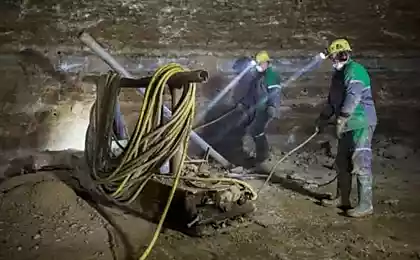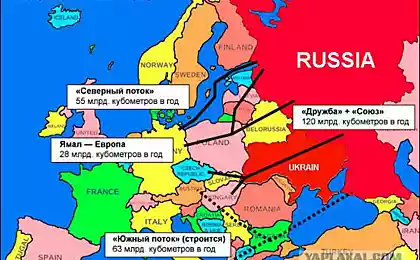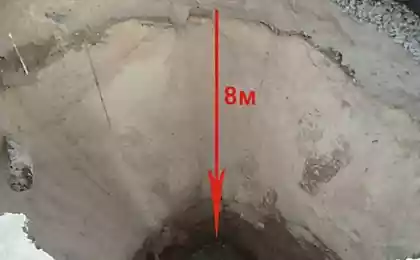1106
Shale apocalypse "Gazprom"
Topic comes up in the light of recent events constantly, so I suggest to your attention a review article that there are shale gas and why the hype around it. The article did not agree with everything, but because everyone is entitled to an opinion ...
"The current trend of the season - shale gas. Experts predict that it will replace other outdated and unfashionable gases and conquer the world economy. So, today in the program: What is shale gas, why so much noise around it and where in the end to put the waste proppants?
Text: Leonid Kaganov, Andrew Konyaev
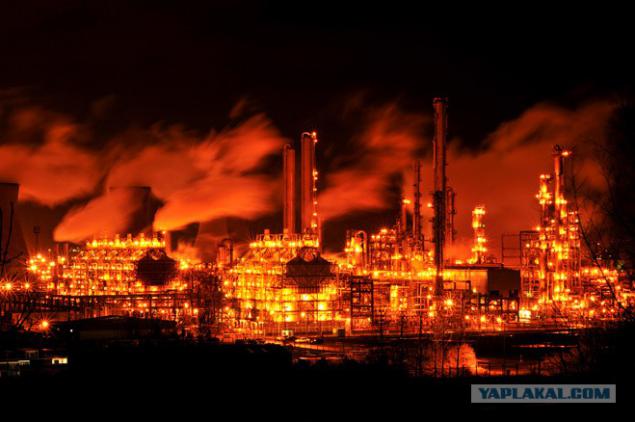
Technology
A brief history of energy production over the past four billion years
The first gas producers were about four billion years ago, immediately after the appearance of the planet. In those early years, Earth's atmosphere is composed almost entirely of methane. Because methane - the third most common gas in the universe after hydrogen and helium, which are of interest only to fans of balloons. In those days the peoples of the Earth - unicellular cyanobacteria - just took methane from the air for their needs, and emits waste - oxygen. Mining was so easy that the first three billion years, none of them did not even occurred to me to become multicellular. Feast freebies ended not just the energy crisis, and this environmental disaster: the atmosphere of the planet was hopelessly poisoned by oxygen, and all of the methane from it vyzhrat and buried in the ground. Survive without revolutionary methods of production was impossible. And cyanobacteria are gone. And instead of them during the last billion years blossomed everything multicellular wonderful diversity that we know and love - from cucumber and fern to brontosaurus and Lady Gaga. These took up the production of organic matter with the mind - then removing it from the depths of its roots, then robbing run past. But energy burial still sank deeper and deeper into the ground. And then God created man so that he took from the depths of the precipitated organic matter turnover and put it back into circulation. This is the main mission of humanity. Let's see how it copes with it.
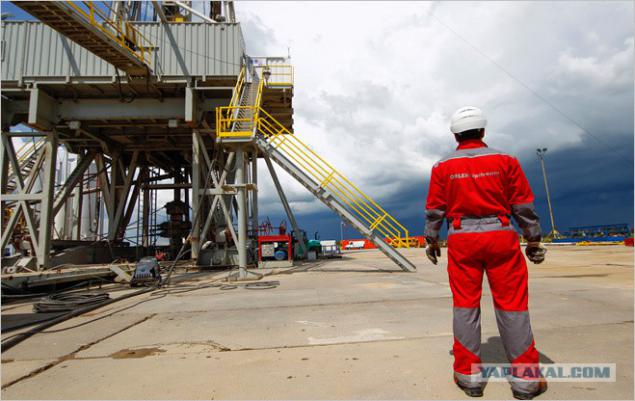
The history of resource extraction humanity
In archaic times, oil and gas Purley from all cracks of the earth. Farmers turned up their noses, and black mud puddles of oil used to lubricate the axles of chariots, and embalming the dead. For the first oil wells were drilled not, but just dug wells. And if the oil is diluted with water provided, the field was considered unfit. Later they began to drill the well, there was a fountain of oil, and drillers bathed in black jets and posed for photographers, preliminary injunction set fire to magnesium flash. Through some hundred years already considered happiness to develop the field, filling in the subsoil water and yielding a ten percent solution. Then people have learned to drill mine incredible depth and even dive for oil in the depths of the sea.
The same thing happened with the gas, which is essentially the same as organic. Gas lies beneath the earth. Somewhere it is dissolved in the oil where a water and lying somewhere hydrates - compounds in which the methane molecules are locked into the lattice of water molecules. As the pressure in the interior of a huge, gas moving up through the pores until it rests on the ceiling of the solid rock, bad passes gas. So get natural pocket. Who lives on the floor above was enough gas producers to drill a hole in the ceiling, insert the pipe - and the gas itself flowed from the natural state in the pocket. But the inhabitants of the planet tend to improve methods of production. People began to suspect that oil and gas can be produced even in some way. For example, from shale, sandstone, coal basins or gas hydrates on the ocean floor (their stocks in general are enormous, the Japanese company JOGMEC last year has something to sample extracted from a depth of 1, 3 kilometers around the island of Honshu). Simply put, to replace the single-cell methods of gas coming high-tech. And the first major revolution became shale gas.
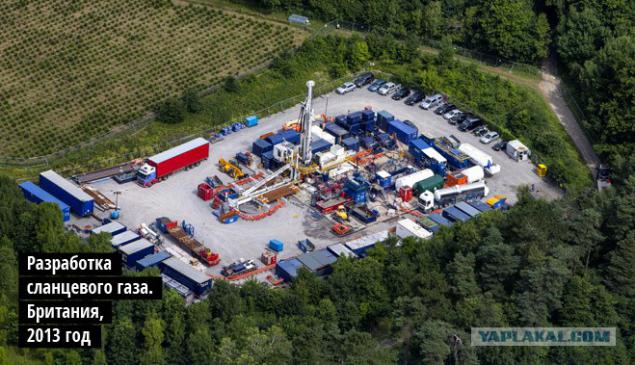
Shale gas
The situation when the gas forms a ready pocket - pleasant, but rare for our times, like a puddle of oil. Most naturally there is no pocket, and decomposed gas on particles in the fractures shale at depths of 1, 5 and 4, 5 kilometers. Drill a hole and insert a tube will not work. Can I get a gas? Possible, but difficult.
To do this you need just three technologies: horizontal drilling, hydraulic fracturing and cluster wells (aka freking). In general, this is reminiscent of mining technology, which invented a million years ago, plants with root system. Drilled a deep well, three kilometers, and when the shale layer is reached, the shaft is rotated further drilled horizontally another three kilometers. And such moves in different directions set. But even so, the gas will not work. Then make fracturing: water is pumped into the mine, which is added in 1% hydrochloric acid, reagents for better dissolution rock granule diameter and 0, 5-1, 5 mm, which stuck into rasklinivshihsya slate plates and give them back together. Usually this sand, but tried to use granules of ceramic, steel, plastic, aluminum oxide, and even ground walnut shells. After fracturing in all branches of the mine in the walls there are hundreds snaking cracks. Water is pumped back as well takes enormous root system and, as a tree begins to pull business with huge depth.
The idea is so simple that it started to come up with a long time ago - in parts. In shale formations first commercial gas well drilled William Hart in the US in 1821. Hydraulic fracturing applied by Halliburton in 1947 in the United States. In the USSR, the theoretical basis of oil shale extraction developed by Soviet scientists Hristianovich and yellow in 1953, and the fracturing of the coal seam was held in 1954 in the Donbass. Since the first decade of hydraulic fracturing is not popular in technology to enhance well production (though only oil), including in Russia.
If it's so simple, what is the difficulty? The complexity of shale gas is that it is very time consuming, so until recently was commercially unprofitable. Depth of about 3 km, the temperature at such depths up to 150 degrees, and the pressure - 600 atmospheres (for comparison: a metal gas tank can withstand high pressure of 300 atmospheres). The thickness of the shale formation may be only 5 meters - try to storm along it and jump out! In general, the problem turned out to be extremely high-tech and has become a truly solved only at current prices for gas and with the advent of computers and the latest telemetry systems, which enables you to control drilling without stopping the drill every 30 meters.
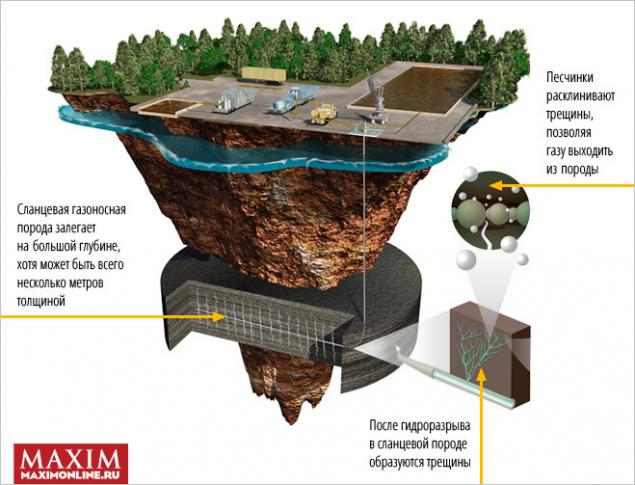
Economy
Number of harvests on the planet as a whole is constant. While you every day varish coffee in the morning, you do not need gas twice as much as yesterday. For the bulk of the world's irony suitable for modern mining stocks was in the earth, in all other respects is not the most attractive, and therefore not the most populated civilized natives. Pleased with easy money natives immediately began to buy their camels instead of "Bentley" and all this continued until until prices have increased so much that the world became profitable high-tech production methods, when you can not dig a hole in the sands of a distant Nigeria and work on private land. So the picture began to change gas winds, which for many years ran around the globe familiar ways.
US gas mostly imported. There are certain fields in the Gulf of Mexico and Colorado, but they began to weaken in the last twenty years. Quarter of its gas bought from the United States of Canada (and even a little then resold to Mexico). A larger share of gas supplied Qatar (this is a country known only to connoisseurs gas economy). Since Qatar is the ocean on the other side of the globe, gas transported in liquid form by tanker. To do this, Qatar had liquefaction terminals, and in the US - liquefaction. Further hope the US was Russian Shtokman field - gas deposits on the Arctic seabed. Difficult to extract, but there is a huge amount of gas. "Gazprom" has promised to initiate the development and sale of liquefied natural gas in the United States.
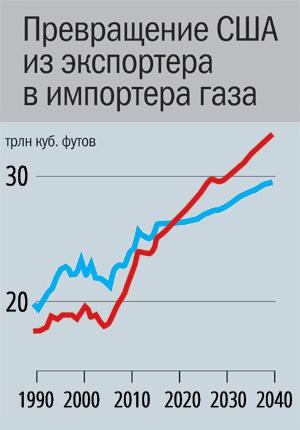
In the US, more than 25% of the total gas production - shale gas. US suddenly turned from gas importer to a net exporter in 2009 even come out on top in the world in terms of production, ahead of Russia (then the volume of production decreased, and Russia once again on the first place, although still gas in the US is cheaper than in Russia). US rebuild all its terminals with liquefaction liquefaction, ready to export overseas.
Canada first began to worry: the demand for Canadian gas in the United States began to decline. But Canada quickly navigate - the contract to supply liquefied natural gas to China, building a terminal in Vancouver and did develop its shale deposits.
Qatar was not needed the United States. He does not know where to put his now liquefied gas, and tries to sell it in Europe.
"Gazprom" was not needed the United States. In 2006, he announced that the Shtokman field gas goes tankers in the United States and the North-European Nord Stream gas pipeline to Europe. And in 2013 a project to develop the Shtokman field in general is suspended. Wind over the ocean has changed and today is blowing in the opposite direction.
Average price per 100 cubic meters
from $ 35 cebestoimost conventional gas production
from $ 385 price at which "Gazprom" sells gas to Europe through the pipe
from $ 500 price at which Qatar drove the US liquefied gas tankers
from $ 100 cost of shale gas
from $ 190 current price of natural gas in the US
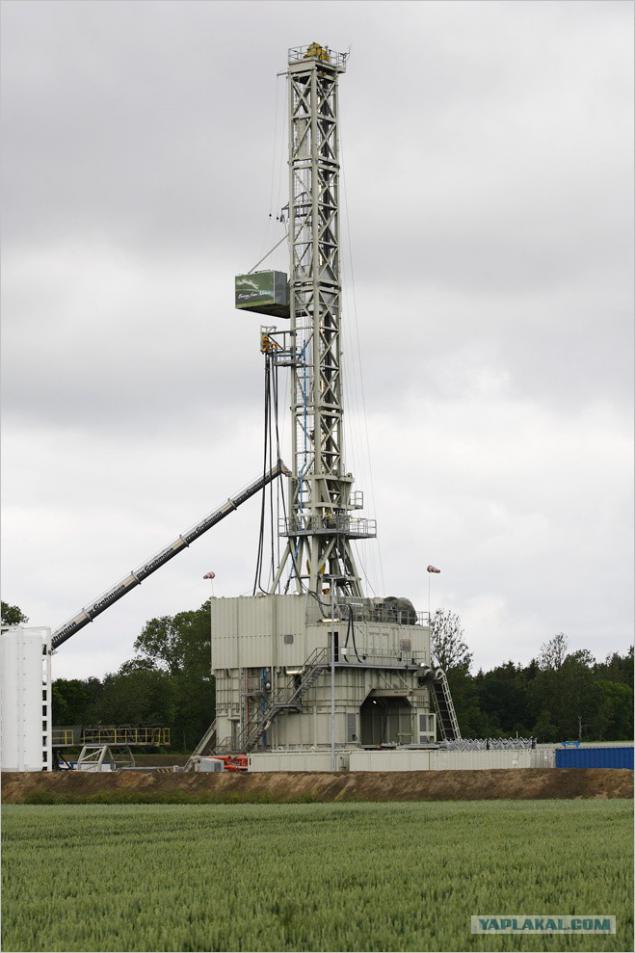
Ecology
The science of ecology - not the most skillful, not the most expensive, but superficially prettiest whore in our world. Included her money - and tomorrow she will tell you that a Boeing deplete the ozone layer, and Airbus - not destroy, or vice versa. It would be strange if it is not connected to the noise around shale gas. Of course, she joined.
Environmental benefits of oil shale mining that hole so deep and so far underground branch that shale gas may be produced in any place where it is, even if proved to be top cities. But opponents argue that shale mining is dangerous for the environment: from this earthquake happen, pollution, and the water in the surrounding wells saturated with methane and burn. Supporters quite reasonably argue that shale lie significantly below the aquifers, and on the hypothesis of earthquakes just laugh. However, the arguments of environmentalists have robust grain, which is associated not with technology, but with the work practices. The fact that the fracture is injected into the well huge volume of water with dissolved reagents. And then it should deflate and ... to do something with. Ideal - the next mine. But it is easier to pour. Also, really was a case where the reagent itself escaped from the well and contaminate aquifers. This happened in Pavillion (population - 160 people) in Wyoming. There shales occur at a record low depths.
The complexity of shale gas is that it is very time consuming, so until recently was commercially unprofitable
As for methane contamination (the famous burning water from the tap, as shown in the film-investigation "Gas Country"), it does not matter related to the hydraulic fracturing method: touch during drilling existing in the soil pockets of methane - a common occurrence in any gas production. Another argument of opponents: shale gas in quality worse than the traditional. The truth here is that shale gas is not passed in the bowels clean, as did the traditional gas seeping through the rocks. Therefore, it is actually slightly different composition. If the standard methane gas of about 94% 3, in shale, according to the journal Pipeline and Gas Journal, wide spread - 79, 4 to 95%, 5% proportion of non-combustible gases (nitrogen, carbon dioxide) to 9 3%. Hence especially with transportation, liquefaction and combustion: shale gas may generate when burning 20% more heat (which is dangerous to the burners) and 30% less (which would upset the consumer).

Policy
When the global economy interesting events happen, be sure there are those who would benefit from light them with one side or another. One side we have already considered: the US turned from an importer to an exporter thanks to shale gas, and the capitalization of "Gazprom", the main supplier of conventional gas fell by half.
Opponents of shale gas claim that it is a huge investment bubble that was inflated swindlers from scratch in order to get the Wall Street investment billions. Briefly: shale mining looked so profitable that there attracted a lot of investment, as a result of the price of gas in the US fell sharply and production has become so unfavorable that gas producers went bankrupt, and investors turned their backs. Another argument that opponents argue that the effectiveness of shale was too high, and in practice in shale gas wells is depleted faster than expected. Therefore, the production of shale gas in the US is not growing as fast as predicted optimists, as in other regions, such as Europe, it has not started, because economically feasible.
Indeed, a number of companies planning to start production of shale gas in Poland, Hungary and the Ukraine in 2014, but it was limited test drilling. Commercial wells still have not earned, for various reasons, which go to such rumors, saying that somewhere not agree on a price, somewhere bribed traditional gasman somewhere local European officials demanded a rollback, but not waited ... < br />
Despite these arguments, the bubble burst was not in a hurry. And even from the frames of the film "The gas country" shot lyutymi environmental opponents, at least implies that shale industry in the United States throughout works and brings easy money earners.

Shale gas and we
A separate question - how can influence the further development of oil shale deposits in the Russian economy? Despite the fact that among theorists shale production were Soviet scientists, and some elements of technology in use today, the whole Russia to shale gas is not ready. And it's not a lack of technology, expertise and technology groomed, but just so expensive production is not necessary in a country where so many conventional gas. Even the question of whether Russia is rich shale, still poorly studied as unnecessary. Russia's task is not to find gas and sell available. It is no secret that the standard of living of Russians relatively high - given our domestic prices for services, goods and property that can shock even wealthy Europeans. Roughly speaking, the Russians from the provinces, working lazily and with a bottle, can buy a TV that diagonal, which can not afford a Chinese working in the factory TV 14 hours a day. This increase in our life miraculously coincided with the increase in world fuel prices when oil in 1999 was worth $ 20, but for ten years has risen to $ 140.
There is a risk that "Gazprom" can be disabled from the European pipe because the pipe is needed for gas circulation within Europe without him
Not surprisingly, the Russians over the past ten years have become less stitching, solder, build, and segment revenues from resources in the overall economic picture from year to year only grew.
Shale revolution in the US has already begun to affect us. At least, Qatar gas is not needed overseas and began looking for a place in Europe. If the shale revolution will spread across the ocean and production will start in Europe, there is, according to some estimates, the volume of shale deposits in Poland alone reaches 5, 3 trillion cubic meters (more than our Shtokman field in the Arctic). In addition to its Polish shale reserves began to study as Ukraine, Hungary and other countries. And then there is the risk that the "Gazprom" with all its reserves may be disconnected from the European pipe because the pipe is needed for gas circulation within Europe without its participation. If this scenario becomes a reality in the next decade, the Russian economy it will be very bad news.
Political nuance today also does not add optimism: relations between Russia and the West very cold, so Europe ceteris paribus gladly refuse to buy Russian gas as soon as possible.

5 of favorable conditions for the development of oil shale mining
1 Availability of land. Would land, and shale gas in it there.
2 High tech, well-funded science and political structure of society in which the word "intelligentsia", "creative class" and "hurt smart" are not federal curse.
"The current trend of the season - shale gas. Experts predict that it will replace other outdated and unfashionable gases and conquer the world economy. So, today in the program: What is shale gas, why so much noise around it and where in the end to put the waste proppants?
Text: Leonid Kaganov, Andrew Konyaev

Technology
A brief history of energy production over the past four billion years
The first gas producers were about four billion years ago, immediately after the appearance of the planet. In those early years, Earth's atmosphere is composed almost entirely of methane. Because methane - the third most common gas in the universe after hydrogen and helium, which are of interest only to fans of balloons. In those days the peoples of the Earth - unicellular cyanobacteria - just took methane from the air for their needs, and emits waste - oxygen. Mining was so easy that the first three billion years, none of them did not even occurred to me to become multicellular. Feast freebies ended not just the energy crisis, and this environmental disaster: the atmosphere of the planet was hopelessly poisoned by oxygen, and all of the methane from it vyzhrat and buried in the ground. Survive without revolutionary methods of production was impossible. And cyanobacteria are gone. And instead of them during the last billion years blossomed everything multicellular wonderful diversity that we know and love - from cucumber and fern to brontosaurus and Lady Gaga. These took up the production of organic matter with the mind - then removing it from the depths of its roots, then robbing run past. But energy burial still sank deeper and deeper into the ground. And then God created man so that he took from the depths of the precipitated organic matter turnover and put it back into circulation. This is the main mission of humanity. Let's see how it copes with it.

The history of resource extraction humanity
In archaic times, oil and gas Purley from all cracks of the earth. Farmers turned up their noses, and black mud puddles of oil used to lubricate the axles of chariots, and embalming the dead. For the first oil wells were drilled not, but just dug wells. And if the oil is diluted with water provided, the field was considered unfit. Later they began to drill the well, there was a fountain of oil, and drillers bathed in black jets and posed for photographers, preliminary injunction set fire to magnesium flash. Through some hundred years already considered happiness to develop the field, filling in the subsoil water and yielding a ten percent solution. Then people have learned to drill mine incredible depth and even dive for oil in the depths of the sea.
The same thing happened with the gas, which is essentially the same as organic. Gas lies beneath the earth. Somewhere it is dissolved in the oil where a water and lying somewhere hydrates - compounds in which the methane molecules are locked into the lattice of water molecules. As the pressure in the interior of a huge, gas moving up through the pores until it rests on the ceiling of the solid rock, bad passes gas. So get natural pocket. Who lives on the floor above was enough gas producers to drill a hole in the ceiling, insert the pipe - and the gas itself flowed from the natural state in the pocket. But the inhabitants of the planet tend to improve methods of production. People began to suspect that oil and gas can be produced even in some way. For example, from shale, sandstone, coal basins or gas hydrates on the ocean floor (their stocks in general are enormous, the Japanese company JOGMEC last year has something to sample extracted from a depth of 1, 3 kilometers around the island of Honshu). Simply put, to replace the single-cell methods of gas coming high-tech. And the first major revolution became shale gas.

Shale gas
The situation when the gas forms a ready pocket - pleasant, but rare for our times, like a puddle of oil. Most naturally there is no pocket, and decomposed gas on particles in the fractures shale at depths of 1, 5 and 4, 5 kilometers. Drill a hole and insert a tube will not work. Can I get a gas? Possible, but difficult.
To do this you need just three technologies: horizontal drilling, hydraulic fracturing and cluster wells (aka freking). In general, this is reminiscent of mining technology, which invented a million years ago, plants with root system. Drilled a deep well, three kilometers, and when the shale layer is reached, the shaft is rotated further drilled horizontally another three kilometers. And such moves in different directions set. But even so, the gas will not work. Then make fracturing: water is pumped into the mine, which is added in 1% hydrochloric acid, reagents for better dissolution rock granule diameter and 0, 5-1, 5 mm, which stuck into rasklinivshihsya slate plates and give them back together. Usually this sand, but tried to use granules of ceramic, steel, plastic, aluminum oxide, and even ground walnut shells. After fracturing in all branches of the mine in the walls there are hundreds snaking cracks. Water is pumped back as well takes enormous root system and, as a tree begins to pull business with huge depth.
The idea is so simple that it started to come up with a long time ago - in parts. In shale formations first commercial gas well drilled William Hart in the US in 1821. Hydraulic fracturing applied by Halliburton in 1947 in the United States. In the USSR, the theoretical basis of oil shale extraction developed by Soviet scientists Hristianovich and yellow in 1953, and the fracturing of the coal seam was held in 1954 in the Donbass. Since the first decade of hydraulic fracturing is not popular in technology to enhance well production (though only oil), including in Russia.
If it's so simple, what is the difficulty? The complexity of shale gas is that it is very time consuming, so until recently was commercially unprofitable. Depth of about 3 km, the temperature at such depths up to 150 degrees, and the pressure - 600 atmospheres (for comparison: a metal gas tank can withstand high pressure of 300 atmospheres). The thickness of the shale formation may be only 5 meters - try to storm along it and jump out! In general, the problem turned out to be extremely high-tech and has become a truly solved only at current prices for gas and with the advent of computers and the latest telemetry systems, which enables you to control drilling without stopping the drill every 30 meters.

Economy
Number of harvests on the planet as a whole is constant. While you every day varish coffee in the morning, you do not need gas twice as much as yesterday. For the bulk of the world's irony suitable for modern mining stocks was in the earth, in all other respects is not the most attractive, and therefore not the most populated civilized natives. Pleased with easy money natives immediately began to buy their camels instead of "Bentley" and all this continued until until prices have increased so much that the world became profitable high-tech production methods, when you can not dig a hole in the sands of a distant Nigeria and work on private land. So the picture began to change gas winds, which for many years ran around the globe familiar ways.
US gas mostly imported. There are certain fields in the Gulf of Mexico and Colorado, but they began to weaken in the last twenty years. Quarter of its gas bought from the United States of Canada (and even a little then resold to Mexico). A larger share of gas supplied Qatar (this is a country known only to connoisseurs gas economy). Since Qatar is the ocean on the other side of the globe, gas transported in liquid form by tanker. To do this, Qatar had liquefaction terminals, and in the US - liquefaction. Further hope the US was Russian Shtokman field - gas deposits on the Arctic seabed. Difficult to extract, but there is a huge amount of gas. "Gazprom" has promised to initiate the development and sale of liquefied natural gas in the United States.

In the US, more than 25% of the total gas production - shale gas. US suddenly turned from gas importer to a net exporter in 2009 even come out on top in the world in terms of production, ahead of Russia (then the volume of production decreased, and Russia once again on the first place, although still gas in the US is cheaper than in Russia). US rebuild all its terminals with liquefaction liquefaction, ready to export overseas.
Canada first began to worry: the demand for Canadian gas in the United States began to decline. But Canada quickly navigate - the contract to supply liquefied natural gas to China, building a terminal in Vancouver and did develop its shale deposits.
Qatar was not needed the United States. He does not know where to put his now liquefied gas, and tries to sell it in Europe.
"Gazprom" was not needed the United States. In 2006, he announced that the Shtokman field gas goes tankers in the United States and the North-European Nord Stream gas pipeline to Europe. And in 2013 a project to develop the Shtokman field in general is suspended. Wind over the ocean has changed and today is blowing in the opposite direction.
Average price per 100 cubic meters
from $ 35 cebestoimost conventional gas production
from $ 385 price at which "Gazprom" sells gas to Europe through the pipe
from $ 500 price at which Qatar drove the US liquefied gas tankers
from $ 100 cost of shale gas
from $ 190 current price of natural gas in the US

Ecology
The science of ecology - not the most skillful, not the most expensive, but superficially prettiest whore in our world. Included her money - and tomorrow she will tell you that a Boeing deplete the ozone layer, and Airbus - not destroy, or vice versa. It would be strange if it is not connected to the noise around shale gas. Of course, she joined.
Environmental benefits of oil shale mining that hole so deep and so far underground branch that shale gas may be produced in any place where it is, even if proved to be top cities. But opponents argue that shale mining is dangerous for the environment: from this earthquake happen, pollution, and the water in the surrounding wells saturated with methane and burn. Supporters quite reasonably argue that shale lie significantly below the aquifers, and on the hypothesis of earthquakes just laugh. However, the arguments of environmentalists have robust grain, which is associated not with technology, but with the work practices. The fact that the fracture is injected into the well huge volume of water with dissolved reagents. And then it should deflate and ... to do something with. Ideal - the next mine. But it is easier to pour. Also, really was a case where the reagent itself escaped from the well and contaminate aquifers. This happened in Pavillion (population - 160 people) in Wyoming. There shales occur at a record low depths.
The complexity of shale gas is that it is very time consuming, so until recently was commercially unprofitable
As for methane contamination (the famous burning water from the tap, as shown in the film-investigation "Gas Country"), it does not matter related to the hydraulic fracturing method: touch during drilling existing in the soil pockets of methane - a common occurrence in any gas production. Another argument of opponents: shale gas in quality worse than the traditional. The truth here is that shale gas is not passed in the bowels clean, as did the traditional gas seeping through the rocks. Therefore, it is actually slightly different composition. If the standard methane gas of about 94% 3, in shale, according to the journal Pipeline and Gas Journal, wide spread - 79, 4 to 95%, 5% proportion of non-combustible gases (nitrogen, carbon dioxide) to 9 3%. Hence especially with transportation, liquefaction and combustion: shale gas may generate when burning 20% more heat (which is dangerous to the burners) and 30% less (which would upset the consumer).

Policy
When the global economy interesting events happen, be sure there are those who would benefit from light them with one side or another. One side we have already considered: the US turned from an importer to an exporter thanks to shale gas, and the capitalization of "Gazprom", the main supplier of conventional gas fell by half.
Opponents of shale gas claim that it is a huge investment bubble that was inflated swindlers from scratch in order to get the Wall Street investment billions. Briefly: shale mining looked so profitable that there attracted a lot of investment, as a result of the price of gas in the US fell sharply and production has become so unfavorable that gas producers went bankrupt, and investors turned their backs. Another argument that opponents argue that the effectiveness of shale was too high, and in practice in shale gas wells is depleted faster than expected. Therefore, the production of shale gas in the US is not growing as fast as predicted optimists, as in other regions, such as Europe, it has not started, because economically feasible.
Indeed, a number of companies planning to start production of shale gas in Poland, Hungary and the Ukraine in 2014, but it was limited test drilling. Commercial wells still have not earned, for various reasons, which go to such rumors, saying that somewhere not agree on a price, somewhere bribed traditional gasman somewhere local European officials demanded a rollback, but not waited ... < br />
Despite these arguments, the bubble burst was not in a hurry. And even from the frames of the film "The gas country" shot lyutymi environmental opponents, at least implies that shale industry in the United States throughout works and brings easy money earners.

Shale gas and we
A separate question - how can influence the further development of oil shale deposits in the Russian economy? Despite the fact that among theorists shale production were Soviet scientists, and some elements of technology in use today, the whole Russia to shale gas is not ready. And it's not a lack of technology, expertise and technology groomed, but just so expensive production is not necessary in a country where so many conventional gas. Even the question of whether Russia is rich shale, still poorly studied as unnecessary. Russia's task is not to find gas and sell available. It is no secret that the standard of living of Russians relatively high - given our domestic prices for services, goods and property that can shock even wealthy Europeans. Roughly speaking, the Russians from the provinces, working lazily and with a bottle, can buy a TV that diagonal, which can not afford a Chinese working in the factory TV 14 hours a day. This increase in our life miraculously coincided with the increase in world fuel prices when oil in 1999 was worth $ 20, but for ten years has risen to $ 140.
There is a risk that "Gazprom" can be disabled from the European pipe because the pipe is needed for gas circulation within Europe without him
Not surprisingly, the Russians over the past ten years have become less stitching, solder, build, and segment revenues from resources in the overall economic picture from year to year only grew.
Shale revolution in the US has already begun to affect us. At least, Qatar gas is not needed overseas and began looking for a place in Europe. If the shale revolution will spread across the ocean and production will start in Europe, there is, according to some estimates, the volume of shale deposits in Poland alone reaches 5, 3 trillion cubic meters (more than our Shtokman field in the Arctic). In addition to its Polish shale reserves began to study as Ukraine, Hungary and other countries. And then there is the risk that the "Gazprom" with all its reserves may be disconnected from the European pipe because the pipe is needed for gas circulation within Europe without its participation. If this scenario becomes a reality in the next decade, the Russian economy it will be very bad news.
Political nuance today also does not add optimism: relations between Russia and the West very cold, so Europe ceteris paribus gladly refuse to buy Russian gas as soon as possible.

5 of favorable conditions for the development of oil shale mining
1 Availability of land. Would land, and shale gas in it there.
2 High tech, well-funded science and political structure of society in which the word "intelligentsia", "creative class" and "hurt smart" are not federal curse.







